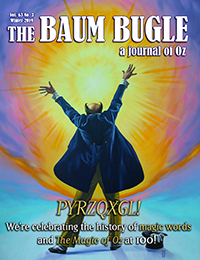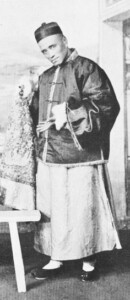A MAGIC NIGHT WITH THE UPLIFTERS
by Ian Davis Smith

Originally published in The Baum Bugle, vol. 63, no. 3 (Winter 2019), pgs. 19–20
Citations
Chicago 17th ed.:
Smith, Ian Davis. “A Magic Night at the Uplifters.” Baum Bugle 63, no. 3 (2019): 19–20.
MLA 9th ed.:
Smith, Ian Davis. “A Magic Night at the Uplifters.” The Baum Bugle, vol. 63, no. 3, 2019, pp. 19–20.
 One evening, over a century ago, L. Frank Baum and a group of his distinguished friends came together to enjoy an evening of social entertainment. They included Harry Kellar, soon to be declared “America’s greatest magician” by fellow wizard Harry Houdini; former Los Angeles County sheriff William Hammel, still nursing the loss of a reelection campaign; and “Mr. Los Angeles” himself, renowned community leader and attorney Joseph Scott. The Uplifters met on the fourth floor of the Los Angeles Athletic Club, in its famous and exclusive Blue Room, to dine and sing songs. That night, they came also to bear witness to the dazzling legerdemain of one of the world’s most renowned conjurers, the Chinese magician Ching Ling Foo. A master of misdirection, and the first Asian illusionist to reach international stardom, Ching graced the Uplifters’ monthly “Hoisting Bee” with an intimate and miraculous performance of Chinese magic.
One evening, over a century ago, L. Frank Baum and a group of his distinguished friends came together to enjoy an evening of social entertainment. They included Harry Kellar, soon to be declared “America’s greatest magician” by fellow wizard Harry Houdini; former Los Angeles County sheriff William Hammel, still nursing the loss of a reelection campaign; and “Mr. Los Angeles” himself, renowned community leader and attorney Joseph Scott. The Uplifters met on the fourth floor of the Los Angeles Athletic Club, in its famous and exclusive Blue Room, to dine and sing songs. That night, they came also to bear witness to the dazzling legerdemain of one of the world’s most renowned conjurers, the Chinese magician Ching Ling Foo. A master of misdirection, and the first Asian illusionist to reach international stardom, Ching graced the Uplifters’ monthly “Hoisting Bee” with an intimate and miraculous performance of Chinese magic.
Ching Ling Foo (real name Zhū Liánkuí) was born in Beijing in 1854, during the Qing Dynasty.1 At the time, Imperial China was wracked with multiple crises: chiefly, anti-Manchu rebellions in the south, as well as tensions with Great Britain that would soon lead to the Second Opium War. Unrest and the harsh climate made life in northern China especially difficult, but for nearly 2000 years, industrious peasant workers had been cultivating a lucrative side hustle to make extra money: magic acts. Conjuring and acrobatic tricks were passed down from generation to generation since the Han Dynasty. The Wuqiao County just south of Beijing became a storied center for the arts, and it was here that Ching Ling Foo honed his craft.
 Details of Ching’s years before celebrity are scarce, but he spent his early adult life in the employ of an international mercantile farm.2 It was not until the age of thirty that he began dabbling in the art of Chinese magic, and then, only as a hobby to impress his friends. Eventually, he found admirers amongst the Chinese high officials, becoming court conjurer to the empress Cixi. In 1898, having caught the attention of visiting foreign dignitaries, he embarked on a sensational vaudeville circuit tour of the United States.
Details of Ching’s years before celebrity are scarce, but he spent his early adult life in the employ of an international mercantile farm.2 It was not until the age of thirty that he began dabbling in the art of Chinese magic, and then, only as a hobby to impress his friends. Eventually, he found admirers amongst the Chinese high officials, becoming court conjurer to the empress Cixi. In 1898, having caught the attention of visiting foreign dignitaries, he embarked on a sensational vaudeville circuit tour of the United States.
At the time, the Chinese Expulsion Act institutionalized prejudice and harsh limits on Chinese immigrants. In 1899, Ching was arrested and targeted for deportation. Fortunately, a judge decided performers were not in the same category as the Chinese laborers the Expulsion Act was designed to repel.3 Despite his setback, Ching managed to achieve great notoriety and played to sold-out crowds.
Throughout any given performance, Ching never spoke, playing to perfection the Western stereotypes of “the inscrutable Chinese.” Audiences were mesmerized, but Ching’s performances also demonstrated wide-ranging skill. He juggled, appeared to pull a fifteen-foot pole from his mouth, and even “decapitated” a boy with a razor-sharp sword. It was, however, his signature act that brought Ching his greatest notoriety.
Alone on stage, dressed in flowing silken robes and a simple black hat, Ching would invite the audience to inspect a large cloth in his possession. It would be found to have no folds or compartments, and the stage was free of trapdoors. Once the audience was satisfied, with the flourish of a matador, Ching would produce a succession of impossible objects from beneath the cloth: plates of food; lighted lamps; live animals; and most famously, an enormous, 100-pound bowl of water. The trick relied on Ching spending most of his waking hours with heavy objects suspended beneath his robes. When the time came to reveal objects from out of “nowhere” on stage, his remarkably natural movements hid the fact that he had them on his person the whole time.
Inevitably, Ching’s fame led to copycat acts across the United States. The most notable of these was “Chung Ling Soo,” who developed an act that not only replicated many of Ching’s tricks but traded on meeting the occasional public challenge from Ching or his management. In reality, “Chung” was Matthew Robinson, a New York native born to Caucasian parents. A talented magician in his own right, he capitalized on the rising interest in Asian magicians and went to enormous lengths to pretend to be Chinese, wearing yellowface makeup and styling his hair into a pigtail. He also pretended he couldn’t speak English, adopting an exaggerated and overtly exotic manner that appealed to the chinoiserie currently en vogue in Western society. The competition between the two magicians was at times intense, and Ching was often frustrated by the audacity of his rival.
Exact dates are unclear, but in 1914 or 1915, Ching was invited to perform for the Uplifters. A gentlemen’s club, the Uplifters were co-founded by L. Frank Baum in 1909, later becoming major financiers of his failed Oz Film Company. Ching appeared as a guest of member Harry Kellar, who introduced his magical contemporary as “the greatest magician in the business.”
Ching was in fine form that night, using the intimate setting of the Blue Room to perform small-scale illusions not possible in packed vaudeville theatres. Ching also declared to the room that he would be returning to China the following week; this might be the last magic he would ever perform in America. Indeed, this was likely to have been Ching’s last visit to the United States; he died between 1918 and 1922 in Shanghai and is buried in Beijing. In their private correspondence, Kellar and Houdini both mourned his passing.
Like many artistic traditions in China, the performing arts were targeted during the Cultural Revolution of the 1960s as being feudalistic, bourgeois, and anti-communist, with magic acts singled out as deceitful practices. They were largely abolished by the
1970s. While this is no longer the case in modern China, the profession has struggled domestically to compete with the spectacle of Western illusionists. It has yet to produce a star who captures the public’s imagination in the same way as did Ching Ling Foo the night he dazzled the creator of Oz.
And what of that magic night in Los Angeles? All we have left is this partial newspaper clipping, taken directly from Houdini’s own scrapbooks. Later that evening, the members in attendance were typically boisterous, conducting and challenging each other to sing and perform, with Baum himself leading the Uplifters in a rousing rendition of the Irish-themed love song “Tipperary.” How much Baum remembered or even enjoyed the magic act isn’t recorded, but his Oz books from 1915 onward are full of transformations, mechanical illusions, and even the odd non-lethal decapitation. It is tempting to think that this brief meeting between two great creative minds, both renowned in their day, left us with a legacy of imagination and magic in Oz.
Thanks to Richard Wiseman and David Britland for sending us this clipping from Harry Houdini scrapbook vol. 38, now housed at the Library of Congress.
1 Stella Björkell, “The art of magic in China,” gbtimes, July 11, 2006, https://gbtimes.com/the-art-of-magic-in-china.
2 “A Wonderful Conjurer.” New York Dramatic Mirror, June 3, 1899.
3 “Chinese Conjurer to Stay,” New York Times, April 27, 1899.
Authors of articles from The Baum Bugle that are reprinted on the Oz Club’s website retain all rights. All other website contents Copyright © 2024 The International Wizard of Oz Club, Inc. All Rights Reserved.
